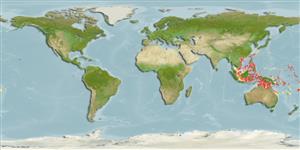>
Gobiiformes (Gobies) >
Gobiidae (Gobies) > Gobiinae
Etymology: Amblyeleotris: Greek, amblys = darkness + The name of a Nile fish, eleotris (Ref. 45335); biguttata: Name from Latin meaning two spots, for the prominent black spots on the chin.
More on author: Randall.
Environment: milieu / climate zone / depth range / distribution range
Ecologia
marino demersale; distribuzione batimetrica 11 - 50 m (Ref. 57552). Tropical
Distribuzione
Stati | Aree FAO | Ecosystems | Presenze | Point map | Introduzioni | Faunafri
Western Pacific: Solomon Islands and New Caledonia.
Size / Peso / Age
Maturity: Lm ? range ? - ? cm
Max length : 10.4 cm TL maschio/sesso non determinato; (Ref. 90102)
Short description
Chiavi di identificazione | Morfologia | Morfometria
Spine dorsali (totale) : 7; Raggi dorsali molli (totale) : 13; Spine anali: 1; Raggi anali molli: 13; Vertebre: 25. Diagnosis: Dorsal rays VI+I, 13; anal rays I, 13; pectoral rays 19; pelvic fins joined by membrane to tips of fifth rays; pelvic frenum present; fourth pelvic ray longest; fifth pelvic ray branching twice. Longitudinal scale series 91-103; no median predorsal scales; scales on side of nape extending to above middle of opercle. Gill opening reaching forward to a vertical about two-thirds orbit diameter behind eye. Body depth 5.8-6.1 in SL; head length 3.6-3.8 in SL; caudal fin pointed and long, 2.2-2.6 in SL. Pale brown dorsally, white ventrally, with three indistinct brown bars on body, and a slightly oblique brown bar from nape across opercle; pale interspaces with small brown blotches, faintly interconnected; a pair of prominent black spots on chin; dorsal fins yellowish grey, the first dorsal with small irregular dark-edged pale blue spots and orange tipped spines, the second dorsal with a broad yellow border containing small dark-edged pale blue spots, the rays tipped with orange; caudal fin with a vertically elongate diffuse brown spot on base (Ref. 57552).
The species inhabits silty sand areas and is associated with unidentified alpheid shrimp, where this species takes refuge in the shrimp's burrow (Ref. 57552).
Life cycle and mating behavior
Maturità | Riproduzione | Deposizione | Uova | Fecundity | Larve
Randall, J.E., 2004. Five new shrimp gobies of the genus Amblyeleotris from islands of Oceania. aqua, J. Ichthyol. Aquat. Biol. 8(2):61-78. (Ref. 57552)
IUCN Red List Status (Ref. 130435: Version 2024-1)
Threat to humans
Harmless
Human uses
Strumenti
Special reports
Download XML
Fonti Internet
Estimates based on models
Preferred temperature (Ref.
123201): 25.8 - 29, mean 27.8 °C (based on 48 cells).
Phylogenetic diversity index (Ref.
82804): PD
50 = 0.5000 [Uniqueness, from 0.5 = low to 2.0 = high].
Bayesian length-weight: a=0.00724 (0.00339 - 0.01546), b=3.10 (2.92 - 3.28), in cm total length, based on LWR estimates for this (Sub)family-body shape (Ref.
93245).
Trophic level (Ref.
69278): 3.3 ±0.4 se; based on size and trophs of closest relatives
Resilienza (Ref.
120179): Alto, tempo minimo di raddoppiamento della popolazione meno di 15 mesi (Preliminary K or Fecundity.).
Fishing Vulnerability (Ref.
59153): Low vulnerability (10 of 100).
